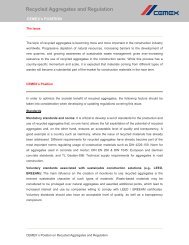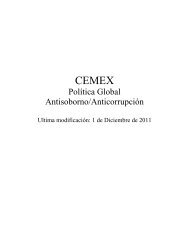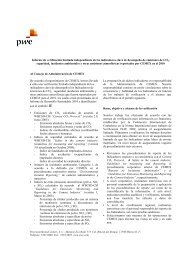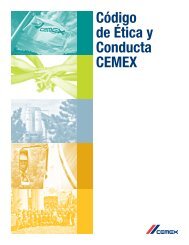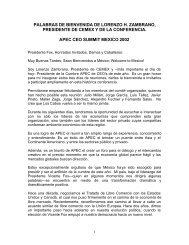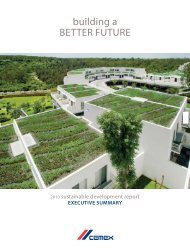building a STRONGER foundation - Cemex
building a STRONGER foundation - Cemex
building a STRONGER foundation - Cemex
Create successful ePaper yourself
Turn your PDF publications into a flip-book with our unique Google optimized e-Paper software.
The construction industry has recently experienced the worst downturn in over 70 years as the fallout from the collapse of the<br />
housing sector caused massive losses in the financial sector, which resulted in extremely tight credit conditions and a deep U.S.<br />
recession that started in December 2007 and ended in June 2009. Under these conditions, cement demand declined 44% from 2006 to<br />
2009. Expansionary monetary and fiscal policies resulted in more stable conditions in 2010, with real GDP growth of 2.9%. As a<br />
result, cement demand stabilized in 2010, declining, however, 1% from 2009. After a 73% decline in housing starts from 2005 to<br />
2009, the housing sector stabilized in the second half of 2009 and improved slightly in 2010, with housing starts up 6%. Nominal<br />
construction spending for the industrial and commercial sector lagged the decline in the economy by a year, with declines of 26% in<br />
2009 and 33% in 2010. Industrial and commercial contract awards, which drive future spending for this segment, declined 19% in<br />
2010, but the pace of its year-over-year decline moderated to 10% in the final quarter of 2010 when compared to 40% in the first<br />
quarter of 2010. Nominal construction spending for the public sector remained more resilient during the recession, increasing 9% in<br />
2008 and 1% in 2009 before declining 6% in 2010. Overall, we believe that cement demand should start growing again as the<br />
economic recovery leads to more job creation and better credit conditions.<br />
Competition. The cement industry in the U.S. is highly competitive. We compete with national and regional cement producers in<br />
the U.S. Our principal competitors in the United States are Holcim, Lafarge, Buzzi-Unicem, Heidelberg Cement and Ash Grove<br />
Cement.<br />
The independent U.S. ready-mix concrete industry is highly fragmented. According to the National Ready Mixed Concrete<br />
Association (“NRMCA”), it is estimated that there are about 6,000 ready-mix concrete plants that produce ready-mix concrete in the<br />
U.S. and about 70,000 ready-mix concrete mixer trucks that deliver the concrete to the point of placement. The NRMCA estimates<br />
that the value of ready-mix concrete produced by the industry is approximately U.S.$30 billion per year. Given that the concrete<br />
industry has historically consumed approximately 75% of all cement produced annually in the U.S., many cement companies choose<br />
to develop concrete plant capabilities.<br />
Aggregates are widely used throughout the U.S. for all types of construction because they are the most basic materials for<br />
<strong>building</strong> activity. The U.S. aggregates industry is highly fragmented and geographically dispersed. According to the U.S. Geological<br />
Survey, during 2010 an estimated 3,900 companies operated approximately 6,000 sand and gravel sites and 1,600 companies operated<br />
4,000 crushed stone quarries and 91 underground mines in the 50 U.S. states.<br />
Our Operating Network in the United States. The maps below reflect the location of our operating assets, including our cement<br />
plants and cement terminals in the United States (including the assets held through the Ready Mix USA LLC joint venture) as of<br />
December 31, 2010.<br />
46



